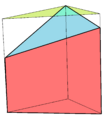Prism (geometry) facts for kids
A Prism is a cool 3D shape that you can find all around you! Imagine a shape with two ends that are exactly the same and perfectly parallel. These ends are called bases, and they can be any polygon (like a triangle, square, or hexagon). The sides connecting these two bases are always parallelograms. If the sides are squares or rectangles, it's called a right prism. If they lean over, it's an oblique prism.
Contents
What is a Prism?
A prism is a special type of polyhedron, which is a 3D shape with flat faces. What makes a prism unique is that it has two identical ends, called bases, that are connected by flat sides. These sides are always parallelograms. If the sides are rectangles or squares, it's called a right prism. This means the sides stand straight up from the bases.
Parts of a Prism
Every prism has a few key parts:
- Bases: These are the two identical polygons at each end of the prism. They can be triangles, squares, pentagons, or any other polygon.
- Lateral Faces: These are the flat sides that connect the two bases. In a right prism, these are rectangles. In an oblique prism, they are parallelograms that lean.
- Edges: These are the lines where two faces meet.
- Vertices (Corners): These are the points where three or more edges meet.
Types of Prisms
Prisms are named after the shape of their bases.
Triangular Prism
A triangular prism has two triangles as its bases. The three sides connecting these triangles are rectangles. Think of a Toblerone chocolate bar or a wedge of cheese!
Rectangular Prism
A rectangular prism has two rectangles as its bases. All its sides are also rectangles. A common example is a brick, a shoebox, or a tall building. A cube is a very special type of rectangular prism where all its faces are squares and are all the same size.
Pentagonal and Hexagonal Prisms
If a prism has pentagons (5-sided shapes) as its bases, it's a pentagonal prism. If it has hexagons (6-sided shapes) as its bases, it's a hexagonal prism. You might see hexagonal prisms in honeycombs or certain crystals.
How Prisms are Used
Prisms are not just shapes in a math book; they are all around us!
In Optics
One of the most famous uses of prisms is in optics. A glass prism can split white light into all the colors of the rainbow, just like a rainbow in the sky. This happens because different colors of light bend at slightly different angles when they pass through the prism. Prisms are used in binoculars, cameras, and other optical instruments.
In Architecture and Design
Many buildings and structures use the shapes of prisms. Tall buildings often have rectangular prism shapes. Even everyday objects like cereal boxes, juice cartons, and gift boxes are often rectangular prisms. This shape is very practical for stacking and storing things.
Calculating with Prisms
You can calculate the volume and surface area of a prism.
Volume of a Prism
The volume of a prism tells you how much space it takes up. To find it, you just need two things:
- The area of its base (the polygon at the end).
- The height of the prism (the distance between the two bases).
The formula is: Volume = Area of Base × Height
For example, if you have a rectangular prism with a base that is 5 cm long and 3 cm wide, its base area is 5 cm × 3 cm = 15 square cm. If the prism is 10 cm tall, its volume would be 15 square cm × 10 cm = 150 cubic cm.
Surface Area of a Prism
The surface area of a prism is the total area of all its faces (the two bases plus all the side faces). Imagine you could unfold the prism flat; the surface area is the total area of that flat shape.
To find it, you add:
- The area of the two bases.
- The area of all the lateral (side) faces.
Images for kids
-
Example truncated triangular prism. Its top face is cut at an angle, but it is NOT an oblique prism!
See also





